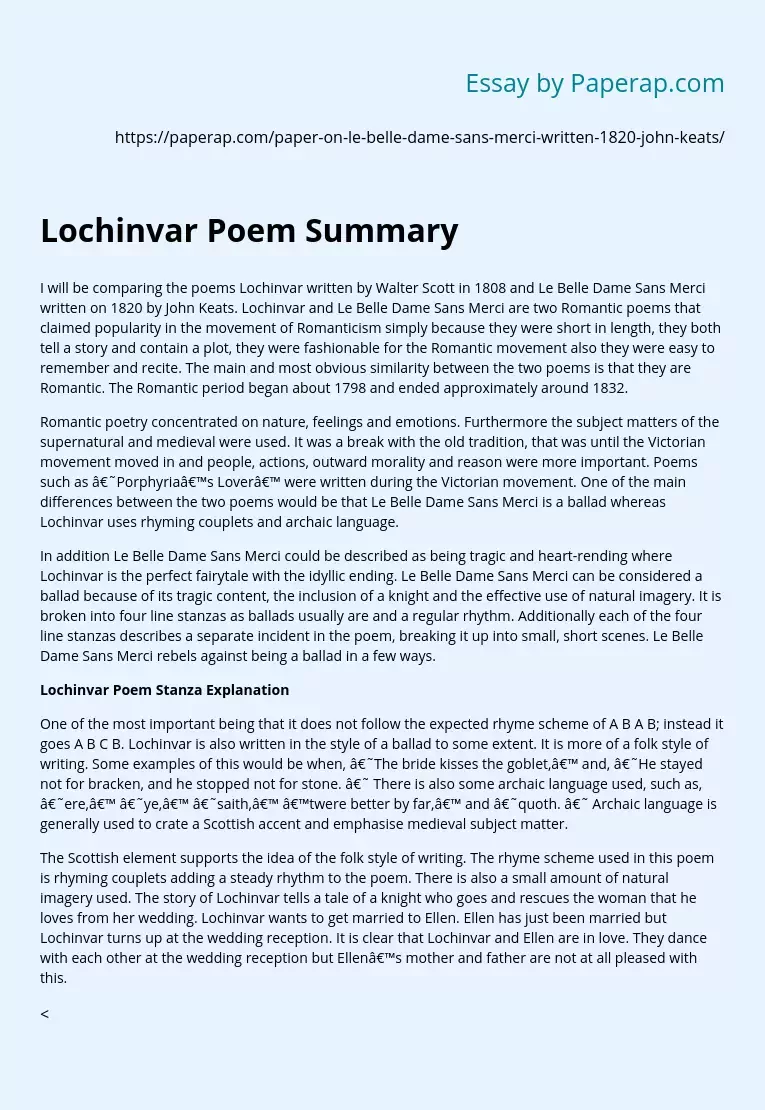Lochinvar Poem Summary
I will be comparing the poems Lochinvar written by Walter Scott in 1808 and Le Belle Dame Sans Merci written on 1820 by John Keats. Lochinvar and Le Belle Dame Sans Merci are two Romantic poems that claimed popularity in the movement of Romanticism simply because they were short in length, they both tell a story and contain a plot, they were fashionable for the Romantic movement also they were easy to remember and recite. The main and most obvious similarity between the two poems is that they are Romantic.
The Romantic period began about 1798 and ended approximately around 1832.
Romantic poetry concentrated on nature, feelings and emotions. Furthermore the subject matters of the supernatural and medieval were used. It was a break with the old tradition, that was until the Victorian movement moved in and people, actions, outward morality and reason were more important. Poems such as ‘Porphyria’s Lover’ were written during the Victorian movement. One of the main differences between the two poems would be that Le Belle Dame Sans Merci is a ballad whereas Lochinvar uses rhyming couplets and archaic language.
In addition Le Belle Dame Sans Merci could be described as being tragic and heart-rending where Lochinvar is the perfect fairytale with the idyllic ending. Le Belle Dame Sans Merci can be considered a ballad because of its tragic content, the inclusion of a knight and the effective use of natural imagery. It is broken into four line stanzas as ballads usually are and a regular rhythm. Additionally each of the four line stanzas describes a separate incident in the poem, breaking it up into small, short scenes.
Le Belle Dame Sans Merci rebels against being a ballad in a few ways.
Lochinvar Poem Stanza Explanation
One of the most important being that it does not follow the expected rhyme scheme of A B A B; instead it goes A B C B. Lochinvar is also written in the style of a ballad to some extent. It is more of a folk style of writing. Some examples of this would be when, ‘The bride kisses the goblet,’ and, ‘He stayed not for bracken, and he stopped not for stone. ‘ There is also some archaic language used, such as, ‘ere,’ ‘ye,’ ‘saith,’ ’twere better by far,’ and ‘quoth. ‘ Archaic language is generally used to crate a Scottish accent and emphasise medieval subject matter.
The Scottish element supports the idea of the folk style of writing. The rhyme scheme used in this poem is rhyming couplets adding a steady rhythm to the poem. There is also a small amount of natural imagery used. The story of Lochinvar tells a tale of a knight who goes and rescues the woman that he loves from her wedding. Lochinvar wants to get married to Ellen. Ellen has just been married but Lochinvar turns up at the wedding reception. It is clear that Lochinvar and Ellen are in love. They dance with each other at the wedding reception but Ellen’s mother and father are not at all pleased with this.
It is at this point that they run away together. Their families attempt to follow them. The main characters in Lochinvar would be Ellen and Lochinvar. Lochinvar is a Scottish Lord and Knight. He is very brave and bold. We know this because, ‘He rode all unarmed and, he rode all alone,’ also ‘He stopped not for break, and he stopped not for stone,’ and ‘He swan the Esk River where ford there was none. ‘ There is some speculation that he could be dangerous. We know that Ellen’s family is quite well off, the live at Netherby Hall. And Ellen’s parents do not approve of Lochinvar.
It could be possible that Ellen’s marriage could be arranged. Lochinvar and Ellen have been in love for some time so maybe Ellen’s parents arranged this marriage to try and exclude Lochinvar from Ellen’s life. The story of Le Belle Dame Sans Merci is that of a tragic one, ending in possible death and mystery. The narrator in the poem meets a knight who looks extremely unwell. The narrator asks the knight what is wrong. He continues to tell the narrator that he met a fairy in the field. He made her some jewellery consisting of flowers, then the fairy tells him that she loves him.
The fairy then took the knight to a cave. She cries and he kisses her. The fairy then sings the night to sleep, then he has bad dreams about death. He then wakes and appears to be in a field. A strong possibility is that the whole encounter could have been a dream. English Literature Kieran Walsh 10E Show preview only The above preview is unformatted text This student written piece of work is one of many that can be found in our GCSE John Keats section.
Lochinvar Poem Summary. (2019, Dec 05). Retrieved from https://paperap.com/paper-on-le-belle-dame-sans-merci-written-1820-john-keats/

